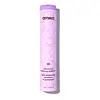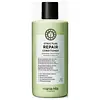What's inside
What's inside
 Key Ingredients
Key Ingredients

 Benefits
Benefits

 Concerns
Concerns

 Ingredients Side-by-side
Ingredients Side-by-side

Water
Skin ConditioningCetyl Alcohol
EmollientStearyl Alcohol
EmollientDicaprylyl Ether
EmollientGlyceryl Stearate
EmollientStearamidopropyl Dimethylamine
EmulsifyingCetrimonium Chloride
AntimicrobialLarix Europaea Wood Extract
HumectantHydrolyzed Rice Protein
Skin ConditioningHydrolyzed Vegetable Protein
Skin ConditioningVp/Dmapa Acrylates Copolymer
Hippophae Rhamnoides Seed Oil
Skin ProtectingSerenoa Serrulata Fruit Extract
Skin ConditioningUrtica Dioica Extract
AstringentMorus Alba Root Extract
BleachingCamellia Sinensis Leaf Extract
AntimicrobialGlycine
BufferingGlycerin
HumectantPouteria Sapota Seed Oil
EmollientPersea Gratissima Oil
Skin ConditioningPolyquaternium-37
Polysorbate 20
EmulsifyingHydrogenated Polydecene
EmollientEthylhexylglycerin
Skin ConditioningTrideceth-6
EmulsifyingSodium Metabisulfite
AntioxidantZinc Chloride
AntimicrobialCitric Acid
BufferingPhenoxyethanol
PreservativeParfum
MaskingTocopherol
AntioxidantDisodium EDTA
Etidronic Acid
Benzalkonium Chloride
AntimicrobialBenzyl Alcohol
PerfumingPotassium Sorbate
PreservativeSodium Benzoate
MaskingButylphenyl Methylpropional
PerfumingHydroxycitronellal
PerfumingHydroxyisohexyl 3-Cyclohexene Carboxaldehyde
MaskingLimonene
PerfumingWater, Cetyl Alcohol, Stearyl Alcohol, Dicaprylyl Ether, Glyceryl Stearate, Stearamidopropyl Dimethylamine, Cetrimonium Chloride, Larix Europaea Wood Extract, Hydrolyzed Rice Protein, Hydrolyzed Vegetable Protein, Vp/Dmapa Acrylates Copolymer, Hippophae Rhamnoides Seed Oil, Serenoa Serrulata Fruit Extract, Urtica Dioica Extract, Morus Alba Root Extract, Camellia Sinensis Leaf Extract, Glycine, Glycerin, Pouteria Sapota Seed Oil, Persea Gratissima Oil, Polyquaternium-37, Polysorbate 20, Hydrogenated Polydecene, Ethylhexylglycerin, Trideceth-6, Sodium Metabisulfite, Zinc Chloride, Citric Acid, Phenoxyethanol, Parfum, Tocopherol, Disodium EDTA, Etidronic Acid, Benzalkonium Chloride, Benzyl Alcohol, Potassium Sorbate, Sodium Benzoate, Butylphenyl Methylpropional, Hydroxycitronellal, Hydroxyisohexyl 3-Cyclohexene Carboxaldehyde, Limonene
Water
Skin ConditioningCetearyl Alcohol
EmollientPPG-3 Benzyl Ether Myristate
EmollientBehentrimonium Chloride
PreservativeZea Mays Starch
AbsorbentOlea Europaea Fruit Oil
MaskingCystoseira Compressa Extract
Benzyl Alcohol
PerfumingHelianthus Annuus Seed Oil
EmollientPhyllostachys Nigra Leaf Extract
Skin ConditioningPolyglyceryl-3 Polyricinoleate
EmulsifyingGlycerin
HumectantGluconolactone
Skin ConditioningAmodimethicone/Morpholinomethyl Silsesquioxane Copolymer
Stearamidopropyl Dimethylamine
EmulsifyingDimethiconol
EmollientTrideceth-5
EmulsifyingQuaternium-95
UV AbsorberDimethicone
EmollientPropanediol
SolventCalcium Gluconate
HumectantCetrimonium Chloride
AntimicrobialPentaerythrityl Tetra-Di-T-Butyl Hydroxyhydrocinnamate
AntioxidantLactic Acid
BufferingSodium Benzoate
MaskingDehydroacetic Acid
PreservativeBenzoic Acid
MaskingPhenoxyethanol
PreservativeMoringa Oleifera Seed Oil
EmollientParfum
MaskingCI 47005
Cosmetic ColorantCI 61570
Cosmetic ColorantWater, Cetearyl Alcohol, PPG-3 Benzyl Ether Myristate, Behentrimonium Chloride, Zea Mays Starch, Olea Europaea Fruit Oil, Cystoseira Compressa Extract, Benzyl Alcohol, Helianthus Annuus Seed Oil, Phyllostachys Nigra Leaf Extract, Polyglyceryl-3 Polyricinoleate, Glycerin, Gluconolactone, Amodimethicone/Morpholinomethyl Silsesquioxane Copolymer, Stearamidopropyl Dimethylamine, Dimethiconol, Trideceth-5, Quaternium-95, Dimethicone, Propanediol, Calcium Gluconate, Cetrimonium Chloride, Pentaerythrityl Tetra-Di-T-Butyl Hydroxyhydrocinnamate, Lactic Acid, Sodium Benzoate, Dehydroacetic Acid, Benzoic Acid, Phenoxyethanol, Moringa Oleifera Seed Oil, Parfum, CI 47005, CI 61570
Ingredients Explained
These ingredients are found in both products.
Ingredients higher up in an ingredient list are typically present in a larger amount.
Benzyl Alcohol is most commonly used as a preservative. It also has a subtle, sweet smell. Small amounts of Benzyl Alcohol is not irritating and safe to use in skincare products. Most Benzyl Alcohol is derived from fruits such as apricots.
Benzyl Alcohol has both antibacterial and antioxidant properties. These properties help lengthen the shelf life of products. Benzyl Alcohol is a solvent and helps dissolve other ingredients. It can also improve the texture and spreadability.
Alcohol comes in many different forms. Different types of alcohol will have different effects on skin. This ingredient is an astringent alcohol.
Using high concentrations of these alcohols are drying on the skin. They may strip away your skin's natural oils and even damage your skin barrier. Astringent alcohols may also irritate skin.
Other types of astringent alcohols include:
According to the National Rosacea Society based in the US, you should be mindful of products with these alcohols in the top half of ingredients.
Any type of sanitizing product will have high amounts of alcohol to help kill bacteria and viruses.
Learn more about Benzyl AlcoholThis ingredient is a preservative, antimicrobial, and emulsifier. It is often used in cosmetics for its ability to cleanse, condition, and reduce static.
Cetrimonium chloride is a quaternary ammonium salt, meaning it has a water-soluble structure.
Glycerin is already naturally found in your skin. It helps moisturize and protect your skin.
A study from 2016 found glycerin to be more effective as a humectant than AHAs and hyaluronic acid.
As a humectant, it helps the skin stay hydrated by pulling moisture to your skin. The low molecular weight of glycerin allows it to pull moisture into the deeper layers of your skin.
Hydrated skin improves your skin barrier; Your skin barrier helps protect against irritants and bacteria.
Glycerin has also been found to have antimicrobial and antiviral properties. Due to these properties, glycerin is often used in wound and burn treatments.
In cosmetics, glycerin is usually derived from plants such as soybean or palm. However, it can also be sourced from animals, such as tallow or animal fat.
This ingredient is organic, colorless, odorless, and non-toxic.
Glycerin is the name for this ingredient in American English. British English uses Glycerol/Glycerine.
Learn more about GlycerinParfum is a catch-all term for an ingredient or more that is used to give a scent to products.
Also called "fragrance", this ingredient can be a blend of hundreds of chemicals or plant oils. This means every product with "fragrance" or "parfum" in the ingredients list is a different mixture.
For instance, Habanolide is a proprietary trade name for a specific aroma chemical. When used as a fragrance ingredient in cosmetics, most aroma chemicals fall under the broad labeling category of “FRAGRANCE” or “PARFUM” according to EU and US regulations.
The term 'parfum' or 'fragrance' is not regulated in many countries. In many cases, it is up to the brand to define this term.
For instance, many brands choose to label themselves as "fragrance-free" because they are not using synthetic fragrances. However, their products may still contain ingredients such as essential oils that are considered a fragrance by INCI standards.
One example is Calendula flower extract. Calendula is an essential oil that still imparts a scent or 'fragrance'.
Depending on the blend, the ingredients in the mixture can cause allergies and sensitivities on the skin. Some ingredients that are known EU allergens include linalool and citronellol.
Parfum can also be used to mask or cover an unpleasant scent.
The bottom line is: not all fragrances/parfum/ingredients are created equally. If you are worried about fragrances, we recommend taking a closer look at an ingredient. And of course, we always recommend speaking with a professional.
Learn more about ParfumPhenoxyethanol is a preservative that has germicide, antimicrobial, and aromatic properties. Studies show that phenoxyethanol can prevent microbial growth. By itself, it has a scent that is similar to that of a rose.
It's often used in formulations along with Caprylyl Glycol to preserve the shelf life of products.
Sodium Benzoate is a preservative. It's used in both cosmetic and food products to inhibit the growth of mold and bacteria. It is typically produced synthetically.
Both the US FDA and EU Health Committee have approved the use of sodium benzoate. In the US, levels of 0.1% (of the total product) are allowed.
Sodium benzoate works as a preservative by inhibiting the growth of bacteria inside of cells. It prevents the cell from fermenting a type of sugar using an enzyme called phosphofructokinase.
It is the salt of benzoic acid. Foods containing sodium benzoate include soda, salad dressings, condiments, fruit juices, wines, and snack foods.
Studies for using ascorbic acid and sodium benzoate in cosmetics are lacking, especially in skincare routines with multiple steps.
We always recommend speaking with a professional, such as a dermatologist, if you have any concerns.
Learn more about Sodium BenzoateWe don't have a description for Stearamidopropyl Dimethylamine yet.
Water. It's the most common cosmetic ingredient of all. You'll usually see it at the top of ingredient lists, meaning that it makes up the largest part of the product.
So why is it so popular? Water most often acts as a solvent - this means that it helps dissolve other ingredients into the formulation.
You'll also recognize water as that liquid we all need to stay alive. If you see this, drink a glass of water. Stay hydrated!
Learn more about Water